 Stella Cottrell, under exclusive licence to Springer Nature Limited 2019 All rights reserved. No reproduction, copy or transmission of this publication may be made without written permission. No portion of this publication may be reproduced, copied or transmitted save with written permission or in accordance with the provisions of the Copyright, Designs and Patents Act 1988, or under the terms of any licence permitting limited copying issued by the Copyright Licensing Agency, Saffron House, 610 Kirby Street, London EC1N 8TS. Any person who does any unauthorized act in relation to this publication may be liable to criminal prosecution and civil claims for damages. The author has asserted her right to be identified as the author of this work in accordance with the Copyright, Designs and Patents Act 1988. First published 2019 by
Stella Cottrell, under exclusive licence to Springer Nature Limited 2019 All rights reserved. No reproduction, copy or transmission of this publication may be made without written permission. No portion of this publication may be reproduced, copied or transmitted save with written permission or in accordance with the provisions of the Copyright, Designs and Patents Act 1988, or under the terms of any licence permitting limited copying issued by the Copyright Licensing Agency, Saffron House, 610 Kirby Street, London EC1N 8TS. Any person who does any unauthorized act in relation to this publication may be liable to criminal prosecution and civil claims for damages. The author has asserted her right to be identified as the author of this work in accordance with the Copyright, Designs and Patents Act 1988. First published 2019 by
RED GLOBE PRESS Red Globe Press in the UK is an imprint of Springer Nature Limited, registered in England, company number 785998, of 4 Crinan Street, London, N1 9XW.
Red Globe Press is a registered trademark in the United States, the United Kingdom, Europe and other countries. ISBN 9781352005790 paperback This book is printed on paper suitable for recycling and made from fully managed and sustained forest sources. Logging, pulping and manufacturing processes are expected to conform to the environmental regulations of the country of origin. A catalogue record for this book is available from the British Library. A catalog record for this book is available from the Library of Congress. Acknowledgements I would like to acknowledge my warmest thanks to those involved in the production of this book, especially Georgia Park and Amy Brownbridge for producing books within the series; Jayne Martin-Kaye for text design; Barbara Wilson for copyediting; Genevieve Friar for proofreading; and Helen Caunce for her oversight and support.
I am especially grateful to Claire Dorer and Georgia Park for the innumerable tasks they have undertaken to enable the production of the series, their care over the details and their generous encouragement and goodwill. Rollercoaster icon by Straw Dog Design, p. xi; Blood pressure icon by Amy Morgan, p. xii; Graduation icon by Rediffusion, p. xiv; Stressed icon by Nicole Hammond, p. xx; Magnifying glass icon by Nesi Ratna Nilasari, p. 7; Write icon by Arthur Shlain, p. 11; Chat bubble icon by Popular, pp. 11, 19, 41; Ordered list icon by Wireform, p. 13; Vacuum cleaner icon by Nociconist, p. 17; Gardening icon by Milinda Courey, p. 17; Walking icon by Adrien Coquet, pp. 17, 19; Sleeping icon by Adrien Coquet, p. 20; Home icon by Numero Uno, p. 23; Guitar icon by Adrien Coquet, pp. 23, 85; Potted plant icon by Alex Muravev, p. 23; Family icon by Gan Khoon Lay, p. 23; Couch icon by Diego Naive, p. 23; Smile icon by Ester Barbato, p. 25; Radio icon by Genius Icons, p. 25; Comic book icon by Carlo Cario, p. 25; Meditation icon by Juan Pablo Bravo, p. 29; Sun icon by Oksana Latysheva, p. 31; Countryside icon by Symbolon, p. 31; Fish icon by Yasminvisible, p. 33; Seaweed icon by Cristiano Zoucas, p. 33; Timepiece icon by ProSymbols, p. 36; Clock icon by Bmijnlieff, p. 39; Queue icon by Gan Khoon Lay, p. 41; Parking icon by Chameleon Design, p. 46; Coffee icon by Jacob Halton, p. 51; Exterior window icon by Ben Davis, p. 51; Bubbles icon by Chiara Rossi, pp. 52, 53; Study icon by Susannanova, p. 55; Study icon by Adrien Coquet, p. 55; Piggy bank icon by LAFS, p. 59; Credit cards icon by Jeff, p. 59; Cabbage icon by Icon 54, p. 63; Eggs icon by Milinda Courey, p. 63; Fish icon by Vectors Market, p. 63; Teapot icon by David, p. 63; Cacao icon by Mariya Zola, p. 63; Relax icon by Adrien Coquet, p. 68; Yawn icon by Lance Hancock, p. 69; Check icon by Adrien Coquet, p. 71; Cat icon by B Farias, p. 73; Signpost icon by Santri Icon; Design icon by Andrew Nolte, p. 85; Art design icon by Delwar Hossain, p. 85; Camera icon by Bmijnlieff, p. 85; Lightbulb icon by Davo Sime, p. 85; First aid icon by Gregor Cresnar, p. 87; Balance icon by Delwar Hossain, p. 91; Yoga icon by Lluisa Iborra, p. 97; Candles icon by Hopkin, p. 99; Plant icon by Gemma Evans, p. 99; Lotus tea by Vectors Market, p. 99; all from the Noun Project (www.thenounproject.com). 99; all from the Noun Project (www.thenounproject.com).
About this book This book suggests 50 Ways to manage stress whilst a student. It includes: Ways to use, and benefit from, stress Ways to prevent excess stress (at least for more of the time!) Ways to cope when over-stressed Ways to reduce excess stress Many of the suggestions involve an element of self-nurturing, relaxation or fun, so can be enjoyable as well as helpful for relieving stress. Just a taste This is a small book with many big ideas. Each Way is a starting point, offering suggestions of things to do and to think about. Browse these to spark ideas of your own. You may find this small taste is enough in itself to spur you to action or you can follow up suggestions using the resources recommended.
Map your own route Stress is a highly personal experience, so use page ix to get started, then select from the 50 Ways to suit your own circumstances and interests. Be adventurous try out things you might not usually consider. The 50 Ways series This series is especially useful for students who want to dip into a book on an aspect of study or student life that is relevant to them at this point in their studies. The 50 Ways books are easy to carry around for a short burst of inspiration and motivation. This book is not a replacement for specialist counselling, therapies or medical care. How to use this book Get started Begin with the introduction and Ways 15. Become more self-aware Find out more about yourself through trying out different things. Reflect Use the mini self-evaluations to focus your thinking. Reflect Use the mini self-evaluations to focus your thinking.
Then consider possible ways forward suggested by your answers. Choose Decide which of the 50 Ways you want to try out. You dont have to do them all! Commit Once you decide to commit to something, put your whole self behind your decision. Do it! Shape new habits Make stress-management a natural part of your everyday routine. See page x. Find out more Follow up using the recommended resources if you wish.
See pages 11013 or use the reference list to follow up sources numbered in superscript in the text. Shape new habits and ways of thinking Dont wait until you feel stressed It is easier to try out new things when you feel less under pressure. You can start to reduce stress straight away just by making a change. Manage stress longer term by developing a repertoire of coping mechanisms. Flip through the book from time to time to stimulate your thinking and stay on top of stress. Start to shape new habits The Ways suggested in this book arent a quick fix for excess stress but, over time, they will help to build confidence and improve your health and well-being.
Developing good lifestyle habits can help you to use stress effectively, maintain it at reasonable levels and cope better with new challenges. Be active in shaping new habits and new ways of thinking. Most pages provide opportunities to reflect, choose, decide and commit. Put yourself fully behind your good intentions write down what you intend to do, using the I will boxes. Be selective: you dont need to do this on every page. You can use pages 1045 to track and monitor new habits you want to form.
Keep track of your progress. It takes time to form new habits so give it time and keep returning to them. You can use pages 1067 to track your progress with any of the Ways you try out. Feeling panic, anxiety or depression now? If you are feeling highly stressed, anxious, depressed, panicked or are considering harming yourself or others, talk to someone who can help. Dont wait until things get worse. See page xxiii.
Next page

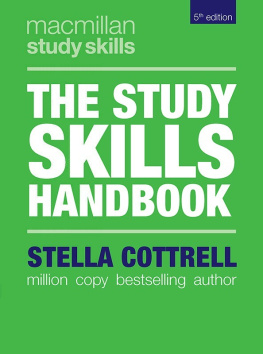
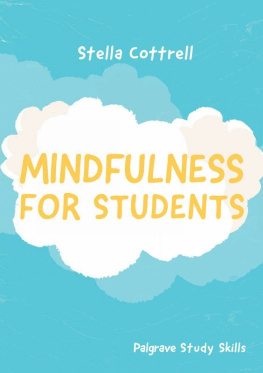

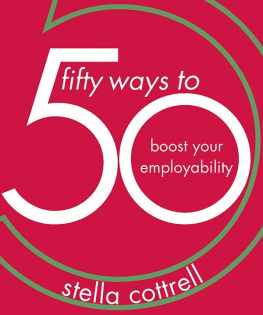
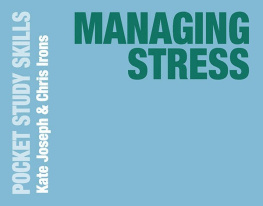
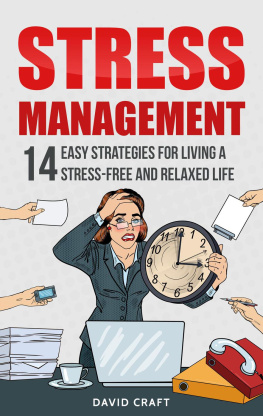
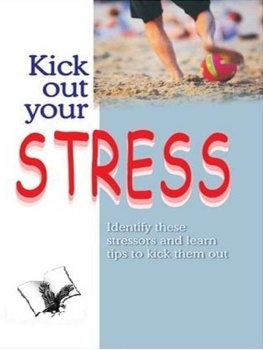

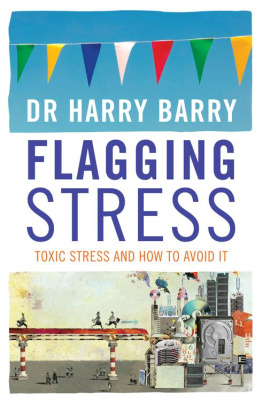
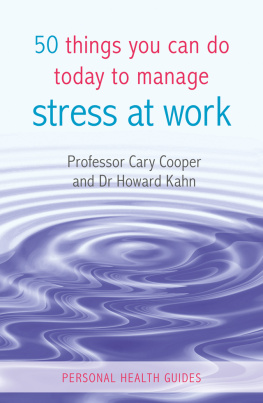
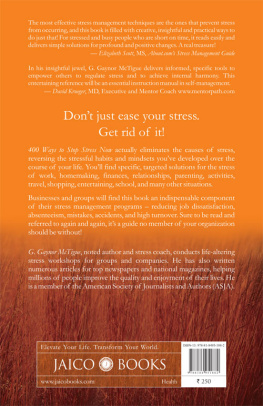


 Stella Cottrell, under exclusive licence to Springer Nature Limited 2019 All rights reserved. No reproduction, copy or transmission of this publication may be made without written permission. No portion of this publication may be reproduced, copied or transmitted save with written permission or in accordance with the provisions of the Copyright, Designs and Patents Act 1988, or under the terms of any licence permitting limited copying issued by the Copyright Licensing Agency, Saffron House, 610 Kirby Street, London EC1N 8TS. Any person who does any unauthorized act in relation to this publication may be liable to criminal prosecution and civil claims for damages. The author has asserted her right to be identified as the author of this work in accordance with the Copyright, Designs and Patents Act 1988. First published 2019 by
Stella Cottrell, under exclusive licence to Springer Nature Limited 2019 All rights reserved. No reproduction, copy or transmission of this publication may be made without written permission. No portion of this publication may be reproduced, copied or transmitted save with written permission or in accordance with the provisions of the Copyright, Designs and Patents Act 1988, or under the terms of any licence permitting limited copying issued by the Copyright Licensing Agency, Saffron House, 610 Kirby Street, London EC1N 8TS. Any person who does any unauthorized act in relation to this publication may be liable to criminal prosecution and civil claims for damages. The author has asserted her right to be identified as the author of this work in accordance with the Copyright, Designs and Patents Act 1988. First published 2019 by